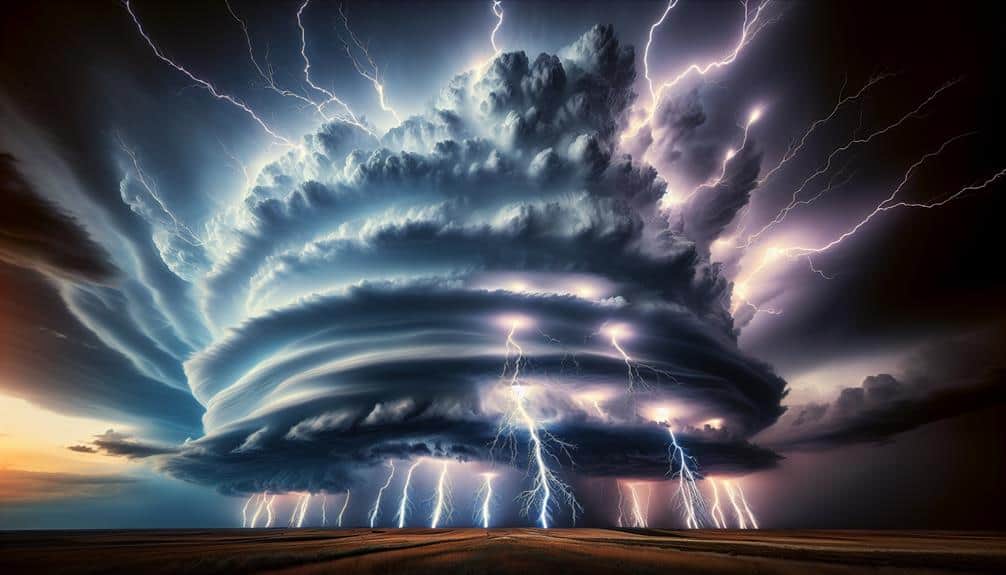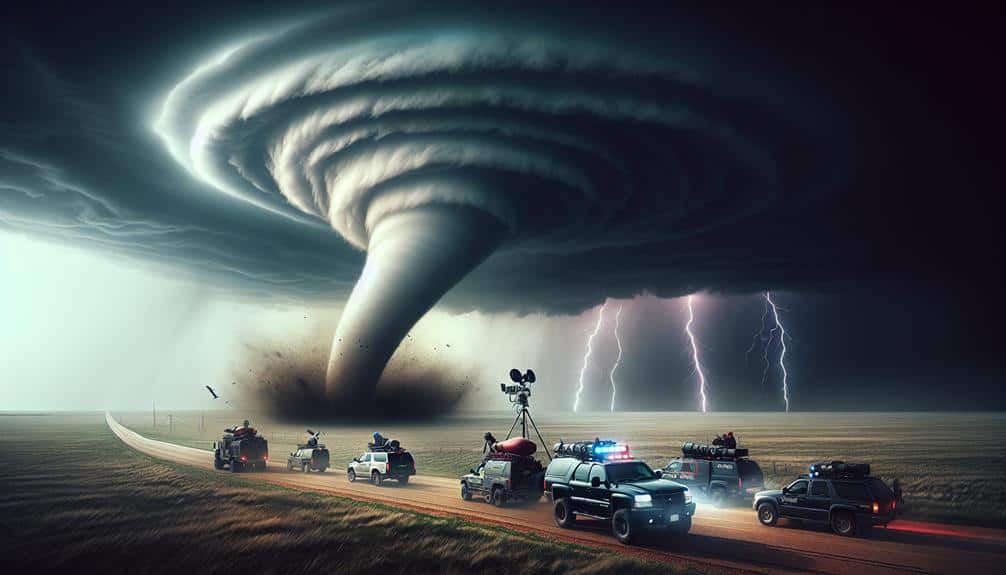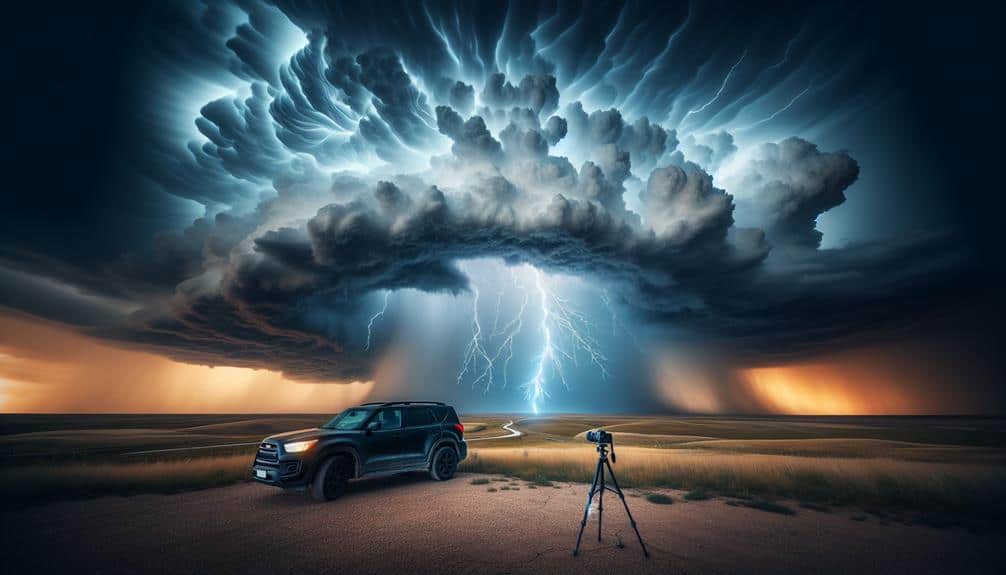These storm chasing championship locations are popular because they offer exceptional opportunities to observe and study tornadoes. Regions like Oklahoma's central area and the Great Plains have ideal atmospheric conditions—such as the convergence of dry and moist air—that foster tornado formation. Advanced technologies like Doppler radar and mobile weather stations provide precise forecasting. The flat terrain in areas like the High Plains enhances visibility, and specialized safety protocols minimize risks. In Dixie Alley, the year-round activity and unique challenges like nocturnal tornadoes add to the appeal. Discover more about the fascinating dynamics at play in these thrilling locations.
Key Points
- High tornado frequency and predictable formation make these regions ideal for storm chasing championships.
- Advanced technology and safety protocols allow safe and efficient storm tracking.
- Flat terrains in the Great Plains and High Plains enhance visibility and storm observation.
- Unique atmospheric conditions in these locations create frequent and intense severe weather events.
Tornado Alley Hotspots
In the heart of Tornado Alley, Oklahoma's central region consistently records the highest frequency of tornadoes, making it a prime hotspot for storm chasers. Our storm chasing culture thrives here, driven by the allure of extreme weather events that peak during tornado season, typically spanning from April to June.
Data from the National Weather Service (NWS) confirms that this region experiences an average of 52 tornadoes annually, a statistic that magnetically draws both amateur and professional storm chasers alike.
We must prioritize safety precautions while engaging in this high-adrenaline pursuit. Advanced technology, such as Doppler radar and real-time storm tracking applications, enhances our ability to predict and follow tornadoes with greater accuracy. Yet, it's essential to remember that these tools are aids, not guarantees of safety. We always need to stay informed about local emergency protocols and have contingency plans in place.
Our collective experience underscores the importance of respecting the formidable power of these extreme weather phenomena. By balancing the thrill of the chase with rigorous safety measures, we can fully embrace the freedom and exhilaration that comes from pursuing nature's most awe-inspiring storms.
Great Plains Attractions
Amidst the vast expanse of the Great Plains, our storm chasing endeavors often intersect with significant meteorological events and unique regional attractions. The Great Plains, known for its sprawling prairie landscapes, offers a prime environment for observing supercells and tornado genesis. The topography, characterized by flat terrain and minimal obstructions, enhances visibility and accessibility, key elements for storm chasing activities.
Our data indicate that the synergy between these natural features and storm dynamics increases the likelihood of witnessing severe weather phenomena. Additionally, the Great Plains boast a unique local culture that enriches our experiences. From local diners to historic sites, the culture here provides a blend of hospitality and history, allowing us to immerse ourselves in the community as we wait for storm systems to develop.
Moreover, meteorological studies show that the convergence of dry air from the Rockies and moist air from the Gulf of Mexico over these prairie landscapes creates ideal conditions for storm formation. This convergence zone, often referred to as the 'dryline,' is a focal point for our forecasting models, enabling us to predict and intercept storms with higher accuracy.
Midwest Severe Weather
Shifting our focus from the Great Plains, we find the Midwest's complex weather patterns offer equally compelling opportunities for storm chasing, driven by frequent interactions between frontal systems and mesoscale convective complexes. This region demands detailed planning and real-time adaptability due to its diverse meteorological phenomena.
We need effective storm chasing strategies and thorough risk assessment to navigate the Midwest's volatile weather. Here's a glimpse of what makes this region a magnet for storm chasers:
- Diverse Weather Systems: The convergence of warm, moist air from the Gulf of Mexico with cold, dry air masses from Canada creates a dynamic environment for severe thunderstorms and tornadoes.
- Advanced Meteorological Tools: High-resolution radar, satellite imagery, and mobile weather stations enhance our storm chasing equipment, allowing us to track storm cells with precision.
- Safety Protocols: Implementing strong safety protocols is essential. We utilize GPS navigation, real-time communication networks, and predefined evacuation routes to guarantee our team's safety.
Our passion for storm chasing in the Midwest is fueled by the freedom to explore these unpredictable yet fascinating weather systems. By leveraging advanced technologies and strict safety measures, we can experience the raw power of nature while minimizing risks.
Dixie Alley Challenges
Let's analyze the challenges of storm chasing in Dixie Alley. Beginning with tornado frequency patterns that differ notably from the Midwest.
We also need to take into account the unique geographical features that complicate visibility and navigation.
In addition, weather prediction difficulties in this region present added hurdles for accurate forecasting.
Tornado Frequency Patterns
Tornado frequency patterns in Dixie Alley present unique challenges due to the region's complex topography and atmospheric conditions. Unlike Tornado Alley, Dixie Alley experiences tornadoes throughout the year, with peak activity in the spring and fall. This variability demands precise tornado frequency analysis to develop effective storm chasing strategies.
1. Seasonal Variability:
Tornadoes in Dixie Alley aren't confined to a single season, making it necessary for us to monitor weather patterns year-round. This requires a dynamic approach to storm chasing that adapts to seasonal shifts.
2. Nocturnal Tornadoes:
A significant proportion of tornadoes in Dixie Alley occur at night, complicating detection and increasing risk. Advanced radar technology and night-vision equipment become essential for safe and effective storm chasing operations.
3. High-Population Density:
The region's dense population and urban areas add layers of complexity. Our strategies must prioritize safety and minimize disruptions while maximizing data collection and analysis opportunities.
Unique Geographical Features
The topography of Dixie Alley, characterized by rolling hills, dense forests, and numerous bodies of water, complicates our storm chasing efforts and requires advanced wayfinding strategies. Unlike the flat expanses of Tornado Alley, Dixie Alley's varied terrain limits visibility and rapid movement. Dense forests obscure our view, making it difficult to track storm development in real-time. Additionally, numerous rivers and lakes often force us to take indirect routes, slowing down our response times.
Data shows that this region is a hotspot for a variety of severe weather phenomena, from coastal hurricanes to mountainous thunderstorms. Navigating these diverse weather patterns necessitates precise planning and data interpretation. The juxtaposition of different geographical features creates microclimates, adding another layer of complexity. For instance, the rolling hills can intensify wind shear, while dense forests can alter storm paths unpredictably.
While desert monsoons and island cyclones present their own unique challenges, Dixie Alley's intricate topography requires a specialized approach. Our ability to adapt to these conditions directly influences our success in capturing these powerful storms. Technological aids like advanced GPS systems and real-time weather data are indispensable for overcoming these geographical hurdles, ensuring we maintain the freedom to chase safely and effectively.
Weather Prediction Difficulties
Traversing Dixie Alley's weather prediction challenges demands our utmost precision and adaptability, as the region's complex microclimates and varied topography often confound standard forecasting models. These intricacies increase meteorological uncertainties, making it difficult to accurately predict storm paths and intensities.
Our primary obstacles include:
- Microclimate Variability: The diverse array of microclimates in Dixie Alley means that even advanced forecasting technology can struggle to account for all variables. Subtle shifts in temperature and humidity can significantly alter storm behavior.
- Topographical Influence: The varied landscape, from rolling hills to dense forests, disrupts wind patterns and creates unpredictable storm trajectories. These geographic factors necessitate real-time adjustments in our predictive models.
- Rapid Storm Development: Extreme weather conditions in Dixie Alley often manifest with little warning, heightening storm chasing dangers. The speed at which these systems develop leaves minimal time for reaction, increasing the risk for those in their path.
Our commitment to leveraging cutting-edge forecasting technology is essential, but it's equally pivotal to recognize the inherent uncertainties we face. By understanding the region's unique challenges, we can better prepare and respond to the extreme weather conditions that define Dixie Alley, ensuring our pursuit of freedom and safety in storm chasing.
Southern Tornado Tracks
Although the southern United States is notorious for its severe weather, data highlights specific areas where tornadoes are most frequent, providing prime opportunities for storm chasers. This region, often referred to as Dixie Alley, includes parts of Alabama, Mississippi, and Tennessee. Here, we can implement advanced storm chasing techniques to analyze tornado formations, leveraging high-resolution radar data and atmospheric models to predict tornado paths accurately.
Our focus on these southern tornado tracks isn't just about the thrill; it's grounded in scientific pursuit and preparedness. By understanding the extreme weather risks, we can develop more effective safety precautions. We employ real-time communication networks and GPS-tracked vehicles to guarantee we maintain a safe distance from the storm's core, mitigating risks while capturing critical data.
Moreover, these areas feature unique meteorological conditions that contribute to frequent tornado outbreaks. Warm, moist air from the Gulf of Mexico collides with cooler, dry air from the west, creating the ideal conditions for supercell thunderstorms. By studying these interactions, we gain insights that enhance broader weather prediction models, ultimately improving public safety and offering us the freedom to chase responsibly and knowledgeably.
High Plains Vortexes
In the High Plains, we encounter vortexes that provide an exceptional opportunity to study the intricate dynamics of tornado genesis and behavior. This region is known for its unique atmospheric conditions, which are conducive to the formation of tornadoes. The relatively flat terrain and the intersection of cold and warm air masses create a perfect setup for extreme weather patterns.
Storm chasing in this area isn't without its dangers, but the data we gather is invaluable.
Here's why the High Plains are a hotspot for storm chasing championships:
- Predictable Tornado Formation: The atmospheric conditions in the High Plains allow us to accurately predict where and when tornadoes will form, improving our chances of capturing valuable data.
- Visibility: The flat, open landscapes provide unobstructed views of the sky, making it easier to observe and document storm structures and vortex behavior.
- Isolation: The sparse population density minimizes the risk to human life and property, allowing us to focus on the scientific aspects without the added concern of widespread damage.
We thrive on the freedom to explore these extreme weather patterns, understanding that the storm chasing dangers are outweighed by the wealth of knowledge gained.
Central U.S. Supercells

Central U.S. supercells offer a prime opportunity to study severe weather phenomena due to their highly organized structure and frequent production of large-scale tornadoes. These supercells present a unique arena for us to refine storm chasing techniques and enhance our understanding of meteorological phenomena. The Central U.S. is characterized by atmospheric conditions conducive to the development of these extreme weather events, especially during the late spring and early summer months.
As storm chasers, our objective is to gather precise data on wind speeds, rotational patterns, and pressure changes within these supercells. By deploying advanced technology such as Doppler radar and mobile mesonets, we can capture real-time information that's critical for improving weather prediction models. Additionally, high-resolution satellite imagery and drone footage allow us to analyze the storm structure and dynamics from multiple perspectives.
Participating in storm chasing championships in the Central U.S. not only satisfies our quest for freedom and adventure but also contributes significantly to the scientific community. The data we collect helps meteorologists better understand the atmospheric conditions that lead to extreme weather events, ultimately improving public safety and preparedness.
Frequently Asked Questions
How Do Storm Chasers Ensure Their Safety During Extreme Weather Events?
We secure our safety during extreme weather by strictly following emergency protocols and meticulously preparing our vehicles. We equip them with advanced meteorological instruments, reinforce their structure, and plan escape routes to maximize our freedom and safety.
What Equipment Is Essential for a Successful Storm Chasing Expedition?
We prioritize safety precautions while using advanced technology. Essential gear includes communication devices, GPS for navigation, and weather radar systems. This guarantees we can track storms accurately and maintain constant communication, enhancing our overall safety and effectiveness.
Are There Any Ethical Considerations for Storm Chasers?
Ironically, we storm chasers, while seeking freedom in nature's fury, must assess our environmental impact and safety concerns. Adhering to a strict code of conduct and prioritizing wildlife preservation guarantees our thrilling pursuits don't cause unintended harm.
How Does Climate Change Impact Storm Chasing Opportunities?
Climate change alters storm patterns, affecting our chasing strategies. With changing weather, we're adapting to unpredictable conditions, leveraging data to maximize safety and success. Freedom to chase demands precise understanding of these evolving dynamics.
Can Amateurs Participate in Storm Chasing or Is It Only for Professionals?
Amateurs can participate in storm chasing, but strict safety precautions are essential. Data shows that proper training and equipment notably reduce risks. Our community values freedom, but we must prioritize safety to guarantee responsible amateur involvement.


